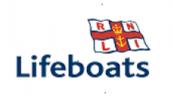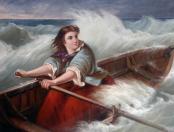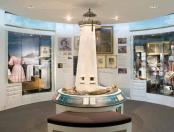North East - Northumberland
![]()
RNLI GRACE DARLING MUSEUM
 Radcliffe Road, Bamburgh,
Radcliffe Road, Bamburgh,
Northumberland
NE69 7AE
t: 01668 214910
e: askgracedarling@rnli.org.uk
w: www.rnli.org/gracedarling
In the true spirit of the lifeboat service, Grace Horsley Darling (1815-42) risked her life to rescue others from certain death in a terrible storm. Grace’s heroism earned her the first RNLI Medal for Gallantry to be awarded to a woman. The RNLI Grace Darling Museum relives the life and times of the girl who became a reluctant celebrity.



Grace’s father, William, was the lighthouse keeper on Longstone in the Farne Islands. In 1838, Grace, a young woman of 22, was living in the lighthouse with her mother, father and one of her brothers. On the night of the rescue her brother was working on the mainland.
At about 4.00am on 7th September, the paddle-steamer SS Forfarshire was wrecked on Big Harcar rock during a wild storm. Grace was on watch in the lighthouse and spotted wreckage, however it was not until about 7.00am that there was light enough to see survivors clinging to the rock. William Darling thought that the atrocious weather would prevent the North Sunderland lifeboat from launching so decided he and Grace would attempt a rescue.
With help from Grace’s mother, the four-oared 6.5 metre boat was launched and Grace and William managed to row the vessel (which normally required several strong men to handle it in such mountainous seas) for nearly a mile. When they reached Big Harcar, William leapt out of the boat to assist the survivors whilst Grace, single-handedly, rowed the coble back and forth to keep it close by, whilst avoiding being smashed on the reef. Nine survivors were rescued from Big Harcar. News of Grace’s part in the rescue spread nationwide and her name became associated with courage and humanity.
The RNLI Grace Darling Museum illustrates Grace’s upbringing and life in the lighthouse, the events of the rescue and her subsequent fame. Grace’s story is told through personal items, including letters, family portraits and the famous coble, or rowing boat. The museum also features atmospheric audio-visual interpretation and a stunning model of Longstone lighthouse.
How to find us: in the village, opposite St Aidan’s church and a short walk from the castle. The large car & coach park is opposite the castle, with public toilets near the museum.
Facilities: Level access on the ground floor; lift to the first floor. There are no public toilets on site; the nearest public toilets are a short distance away on the opposite side of the road (20p suggested donation).
Opening Times:
April - September
Open daily, 10am-5pm (last entry 4.30pm)
October – March
Open Tuesday to Sunday, 10am-4pm (last entry 3.30pm)
Please contact the museum to book your group visit.
Owing to the size of the museum, on busy days non-booked groups may not be able to enter.
The RNLI is a charity, the funds of which are used for emergency service of saving lives at sea.
There is no charge for museum admission, however please consider a discretionary donation towards the RNLI’s work of saving lives at sea (receipts can be provided if required).














